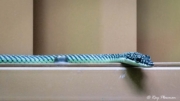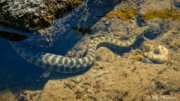Snakes
This photo album contains a single gallery of reptiles, placed in Order Squamata, that I photographed in their natural habitats. The gallery features colubrids, viper, elapid and boa. See the Taxonomy note at the end of this page.
Snakes


Snake Notes
All featured species are ‘Red List 2019’ assessed as ‘Least Concern’.
Colubrids are the largest snake family with nearly 2000 species, mostly non-venomous, although some Asian genera have caused human fatalities.
Oriental Whip Snake is a diurnal, arboreal species found in many habitats, including urban and rural gardens but prefers forest edge. I photographed the species in Singapore’s Botanical Garden and the forest on Coney Island. Feed on vertebrates, including small nesting birds, lizards, and frogs.
Paradise Gliding Snake is a diurnal and arboreal species that feeds on lizards and small birds. Habitat includes forest, mangroves, and urban areas. I photographed both images in Singapore, the first in the woods at Coney Island and the second in the gent’s urinal toilet at Labrador Nature Reserve.
Striped Bronzeback is a non-venomous, long slender snake with large eyes. It is diurnal and arboreal but often comes to the ground in secondary growth, forest, and scrubland habitat. They feed on frogs, lizards, and possibly young birds.
Viperine Water Snake preferred habitat is rapidly flowing rivers and streams, close to or in waterbodies such as streams, ponds, meadows, open woodlands. It is a small non-venomous snake whose diet includes frogs, newts, fish, eggs, and other aquatics.
Western Whip Snake is non-venomous, probably a young snake being a grey / brown with a marbled head. Found in all types of habitat and prey such as small mammals, small birds, frogs and lizards, photographed along a roadside verge in Peyreleau village in the Tarn Gorges.
Vipers
Shore Pit Viper is a dangerously verminous arboreal and nocturnal species that I photographed close to a footpath in Singapore’s Sungei Buloh Wetland Reserve. It is unpredictable and will strike without warning; its venom can cause severe illness or death. Found in mangroves, coastal forests and swamps. They grow to 1 m and seen low down on tree branches during the day. They feed on lizards, frogs, and small animals, possible little birds. I watched this snake for around five minutes; it hardly changed position, looking like it kept still. When I later examined my images, I realised that it was homing in on its next meal, a Lineate Nerite (Nerita balteata) snail. I missed the potential kill as I was on my way to photograph Ospreys.
Elapids
Banded Krait sightings of this highly venomous elusive snake are rare. It is not aggressive during the day, but it can be dangerous at night when it is more active. A common throughout Southeast Asia, the primary habitat is forest, agricultural land, and coastal areas often near water. I photographed this specimen in the low light of the mangrove swamp in Kuala Selangor Nature Park, where it was hunting. They feed on vertebrates such as rodents and lizards.
Boas
Ruschenberger Tree Boa photographed in Trinidad’s Caroni Swamp. An arboreal species found in forests, savanna often coiled up in a tree near open water. They are nocturnal, feeding on rodents, birds, bats, and lizards. They are non-venomous, killing prey by bite and constriction. Trinidad’s population are pure bronze with patterns.
Snake Taxonomy
The Reptiles Photo Album webpage describes the higher-level taxonomy for the featured families placed in suborder Serpentes part of the Squamata (Lizards, Skinks, Snakes) order.
Infraorders Alethinophidia with twenty families and Scolecophidia with five families contain more than 3,000 known species of Serpentes (Snakes).
The photo gallery display species from the following four Alethinophidia families: Colubridae (Colubrids), Viperidae (Vipers), Elapidae (Elapids), and Boidae (Boas).








